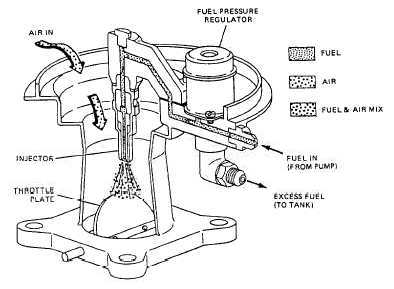In the continuous system, fuel is delivered to the mixture control unit by the fuel pump. The fuel pressure regulator maintains fuel line pressure by sending excess fuel back to the gas tank.
The mixture control unit regulates the amount of fuel that is sent to the injectors, based on the amount of airflow through the intake and the engine temperature. The mixture control unit on mechanical systems is operated by the airflow sensing plate and the warm-up regulator. This information on an electronic system is fed into a computer that regulates the fuel injection rate.
The accelerator pedal regulates the rate of airflow through the intake by opening and closing the throttle valve. A cold-start injector is installed in the intake to provide a richer mixture during engine start-up and warm-up. It is actuated by electric current from the thermal sensor whenever the temperature of the coolant is below a certain level. The cold-start injector works in conjunction with the auxiliary air valve. Its function is to speed up the engine idle during warm-up. It is also actuated by the thermal sensor.
THROTTLE BODY INJECTION SYSTEMS
Throttle body injection (fig. 5-4) is a form of continuous injection-one or two injectors delivering gasoline to the engine from one central point in the intake manifold. Though throttle body injection does not provide the precise fuel distribution of the direct port injection, it is cheaper to produce and to provide a degree of precision fuel metering. The throttle body injection unit is usually an integral one and contains all of the major system components. The unit mounts on the intake manifold in the same manner as a carburetor. Airflow sensors and electronic computers usually are mounted in the air cleaner body.
SERVICING AND PRECAUTIONS
When a vehicle equipped with a gasoline type of fuel injection system has a problem, check all other systems first, such as ignition, air intake, charging, exhaust systems, and so forth-before you work on the fuel injection system. The fuel injection system is usually the last (least problematic) system to cause trouble. There are servicing precautions you should observe before you work on gasoline fuel injection systems.
1. Do not jump the battery to start the vehicle.
2. Do not disconnect the battery cables from the battery with the engine running.
3. When charging a battery in the vehicle, disconnect the negative (grounded) terminal.
4. Do not remove or attach the wiring harness plug to the electronic control unit (computer) with the ignition on.
5. Before performing a compression test, check the manufacturer's repair manual for special instructions.
6. Always make sure all other systems are in good working order before you adjust or troubleshoot the gasoline fuel injection system.
These precautions are general and apply to most systems. Nevertheless, use good judgment, and always

Figure 5-4.-Throttle body injection.
Continue Reading